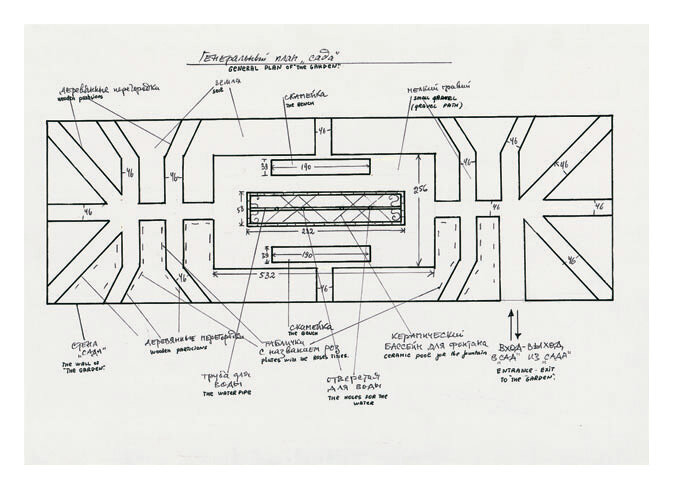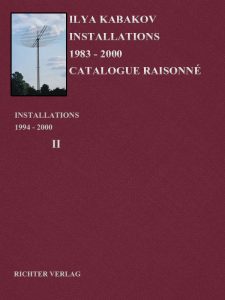No Water
YEAR: 1995
CATALOG NUMBER: 91
PROVENANCE
The Artist
Collection Österreichisches Museum für Angewandte Kunst (mak), Vienna
NOTES
See No 42
EXHIBITIONS
Austrian Museum for Applied Arts (Österreichisches Museum für Angewandte Kunst, mak), Vienna
Permanent installation of the Austrian Museum for Applied Arts in the former Gefechtsturm Arenbergpark, 10 Sep 1995
The upper part of the glasshouse, which was built in 1994 for the presentation of the Red Wagon was reutilized for this installation
DESCRIPTION
This installation is a ‘greenhouse’ built inside of a large but low glass enclosure 20 m long by 7 meters wide by 2.4 meters high and constructed of metal beams, all covered by glass. The ‘greenhouse’ has a door, and it is possible to enter the space. The space is brightly lit by eight lamps. These hang from the ceiling of the building, suspended above the ‘greenhouse,’ and they cast light through the glass ceiling of the ‘greenhouse.’ When the viewer peers inside, and especially when he enters the ‘greenhouse,’ he can see the beautifully and carefully planned little garden, a kind of ‘park.’ There are precise lines of flower beds, footpaths sprinkled with gravel, and a small central clearing in the middle of this ‘garden.’ Stuck in the soil in the flower beds are over 100 plates with names and botanical descriptions of roses. It appears as if they have already been planted.
In the central clearing, covered with pink gravel, is a small, shallow reflecting pool lined with white, blue and pink ceramic tile up to its edges. In the center of this pool is a water pipe with sprinklers for the future fountain. On either side of the fountain is a low bench – a place for relaxation and meditation in the future ‘rose garden.’ Everything is designed and prepared for quiet, solitude, happiness, except for one small detail; one sad problem which is mentioned in the title of the installation, placed at the entrance: ‘No Water!’
Roses
Gallica (also called Rose of Provence.) A variety of rosa gallica, native of southern France. Height up to 1.5 meters. Very hardy, strongly scented flowers, ranging from pink to purple.
Damask. A hybrid between R. Gallica and R. Phoenicea. Less Hardy than Gallicas, often taller, up to 2.5 meters, with red, pink and white flowers in loose clusters.
Tea. The tea rose. Rosa X Adorata. A hybrid between R. Gigantea and R. Chinensis. Has large flowers in shades of pink, buff or light yellow.
Hybrid perpetual. First appeared about 1835. Usually red, mauve, pink or white, often with huge flowers and strong shoots. (American hardiness zone iv-v.)
Wichuraiana Ramblers. Two very different looking groups. The large-flowered are similar to Hybrid Teas R. Luciae. The small-flowered are a cross between R. Setigera and Synstylae.
Rugosas. A very hardy species from N. Japan and Siberia. They are all thorny, with very fragrant flowers.
English Roses. The parentage of this is ‘Belle Isis’ (a Gallica 1845) and ‘Dainty Maid’ (a Floribunda 1940).
CONCEPT OF THE INSTALLATION
The idea of the installation emerged unexpectedly in connection with the place where it was erected. Furthermore, its main part – the glass construction – had already been built. This was the upper section of a glass case that had housed The Red Wagon when it had stood for a rather long time in the open space of the mak Museum in Vienna. I suddenly had to think of something, starting with what was already there. This was the third floor of an enormous cement bunker built by the Nazis at the end of the war in anticipation of air bombing raids. This is a high, gloomy structure, and inside it is especially depressing: a cement ceiling, walls and floor, weak lighting, gloomy stairs and hallways. Of course, there are no windows.
Under these circumstances, the installed greenhouse – the idea for which, I repeat, occurred to me suddenly, without any preliminary contemplation – should have created a sharp and paradoxical impression: who could have thought to build a greenhouse in such a place? But perhaps, someone really did think of building it here? The wildness of the place itself, its very absurdity and senselessness – as everyone knows, Vienna was taken without any air raids at all – only magnifies the absurdity of everything that now stands inside, it added a certain delirium and strangeness to any installation that might be placed on this floor, including the greenhouse built here: in a delirious place nothing will seem too delirious, including the construction of a ‘corner of paradise’ in this hellish place. The low hanging bulbs played the role of many ‘suns’ in this paradise. The paths, fountain, benches, all prepared and organized this ‘paradise’ visually, but ‘there is no water.’ And this pronouncement – they didn’t ‘give’ any water to this place, or it was turned off, or what is even more terrible, they never even thought of running water to this place – is the basic metaphor of this installation: the idea of ‘Potemkin villages,’ of any political camouflage, falsification, deceit, of any artificial structure.
Obviously, such an installation is rather politicized. But it could not be otherwise in such a place where history still lives so mercilessly and inflammatorily, in a space that has not yet turned into romantic ruins. Air is essential for ruins, but this place was more reminiscent of surrealistic catacombs, where not only could there be no water, but there was also instinctive fear that the very flow of air could also be cut off. And the strongest impression was created by the electric lighting, by the small, bright bunker bulbs against the background of the dark gray bunker walls, the burning hot bright bulbs illuminating and scorching the real earth with the rose seeds where there would never be any water.
Images
Literature






